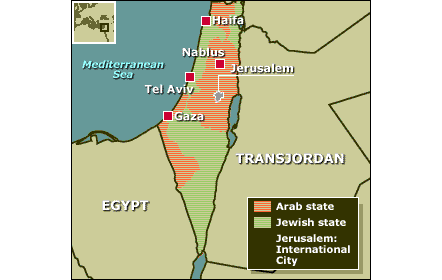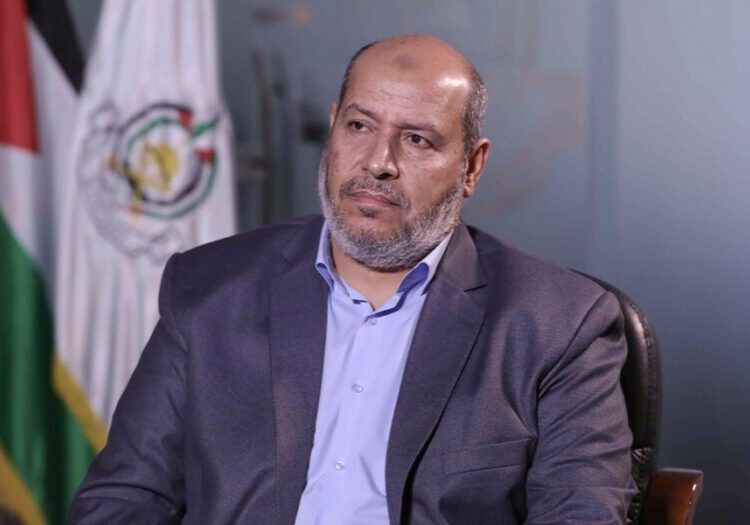Australia/Israel Review
Partition – the Legacy of November 29, 1947
Nov 27, 2017 | Mitchell Bard

Mitchell Bard
As World War II ended, the magnitude of the Holocaust became known. This accelerated demands for a resolution to the question of Palestine so the Displaced Persons, survivors of Hitler’s Final Solution, might find sanctuary in a homeland of their own. The existing Jewish community, the “Yishuv”, was also thriving and ready for independence. The British tried to work out an agreement acceptable to both Arabs and Jews, but their insistence on the former’s approval guaranteed failure because the Arabs would not make any concessions. The British subsequently turned the issue over to the UN in February 1947. The UN established a Special Commission on Palestine (UNSCOP) to devise a solution.
Delegates from 11 nations went to the area and found what had long been apparent: the conflicting national aspirations of Jews and Arabs could not be reconciled. When they returned, the delegates of seven nations – Canada, Czechoslovakia, Guatemala, The Netherlands, Peru, Sweden and Uruguay – recommended the establishment of two separate states, Jewish and Arab, to be joined by economic union, with Jerusalem an internationalised enclave. Three nations – India, Iran and Yugoslavia – recommended a unitary state with Arab and Jewish provinces. Australia abstained.
The Jews of Palestine were not satisfied with the small territory allotted to them by the Commission, nor were they happy that Jerusalem was severed from the Jewish State; nevertheless, they welcomed the compromise. The Arabs rejected UNSCOP’s recommendations.
The ad hoc committee of the UN General Assembly rejected the Arab demand for a unitary Arab state. The majority recommendation for partition was viewed as a more just solution and subsequently adopted by a vote of 33 to 13 with ten abstentions on November 29, 1947.
How land was divided under Partition
Nearly 80% of what was the historic land of Palestine and the Jewish National Home, as defined by the League of Nations, was severed by the British in 1921 and allocated to what became Transjordan.
Jewish settlement there was barred. The UN partitioned the remaining 20-odd percent of Palestine into two states. With Transjordan’s annexation of the West Bank in 1950 and Egypt’s occupation of Gaza, Arabs controlled more than 80% of the territory.
The partition plan took on a checkerboard appearance largely because Jewish towns and villages were spread throughout Palestine. This did not complicate the plan as much as the fact that the high living standards in Jewish cities and towns had attracted large Arab populations, which ensured that any partition would result in a Jewish state that included a substantial Arab population.
Recognising the need to allow for additional Jewish settlement, the majority proposal allotted the Jews land in the northern part of the country, the Galilee, and the large, arid Negev Desert in the south. The remainder was to form the Arab state.
These boundaries were based solely on demographics. The borders of the Jewish State were arranged with no consideration of security; hence, the new state’s frontiers were virtually indefensible.
Overall, the Jewish State was to be comprised of roughly 14,000 sq. kilometres (about 55% of Palestine), and the population was to be 538,000 Jews and 397,000 Arabs. Approximately 92,000 Arabs lived in Tiberias, Safed, Haifa, and Bet Shean, and another 40,000 were Bedouins, most of whom were living in the desert. The remainder of the Arab population was spread throughout the Jewish state. The Arab State was to be around 11,600 sq. kilometres with a population of 804,000 Arabs and 10,000 Jews.
Critics claim the UN gave the Jews fertile land while the Arabs were allotted hilly, arid land. To the contrary, approximately 60% of the Jewish state was to be the desert in the Negev, while the Arabs occupied most of the agricultural land.
Further complicating the situation was the UN majority’s insistence that Jerusalem remain apart from both states and be administered as an international zone. This arrangement left more than 100,000 Jews in Jerusalem isolated from their country and circumscribed by the Arab state.
According to British statistics, more than 70% of the land in what would become Israel belonged to the mandatory government. Those lands reverted to Israeli control after the departure of the British. Another 9% of the land was owned by Jews, and about 3% by Arabs who became citizens of Israel. That means only about 18% belonged to Arabs who left the country before and after the Arab invasion of Israel.
At the time of the 1947 partition resolution, the Arabs did have a majority in western Palestine as a whole – 1.2 million Arabs versus 600,000 Jews. But the Jews were a majority in the area allotted to them by the resolution, and in Jerusalem.
The Jews never had a chance of reaching a majority in the country given the restrictive immigration policy of the British. By contrast, Palestine’s Arab population, which had been declining prior to the Mandate in 1922, grew exponentially because Arabs from all the surrounding countries were free to come – and thousands did – to take advantage of the rapid economic development and improved health conditions stimulated by Zionist settlement.
The Arab response to partition
As the 1947 partition vote approached, it became clear that little hope existed for a political solution to a problem that transcended politics: the Arabs’ unwillingness to accept a Jewish state in Palestine and the refusal of the Zionists to settle for anything less. The implacability of the Arabs was evident when Jewish Agency representatives David Horowitz and Abba Eban made a last-ditch effort to reach a compromise in a meeting with Arab League secretary Abd al-Rahman Azzam Pasha on September 16, 1947.
Pasha told them bluntly:
The Arab world is not in a compromising mood. It’s likely, Mr. Horowitz, that your plan is rational and logical, but the fate of nations is not decided by rational logic. Nations never concede; they fight. You won’t get anything by peaceful means or compromise. You can, perhaps, get something, but only by the force of your arms. We shall try to defeat you. I am not sure we’ll succeed, but we’ll try. We were able to drive out the Crusaders, but on the other hand we lost Spain and Persia. It may be that we shall lose Palestine. But it’s too late to talk of peaceful solutions.
Meanwhile, the Mufti of Jerusalem Haj Amin el-Husseini, the pre-eminent Palesinian Arab leader, and his henchmen made sure to silence supporters of partition. According to one of the Mufti’s associates who spied for the Haganah, “The opposition, which was prepared to agree to partition, had to go along with the opponents of partition after they learned of the decision to murder everyone who supported that opinion, even if they were among the greatest [leaders.]”
The Arabs made clear they would go to war to prevent the establishment of a Jewish state. The Chairman of the Arab Higher Committee said the Arabs would “fight for every inch of their country.”
Two days later, the holy men of Al-Azhar University in Cairo called on the Muslim world to proclaim a jihad (holy war) against the Jews.
Jamal Husseini, the Arab Higher Committee’s spokesman, had told the UN prior to the partition vote that the Arabs would drench “the soil of our beloved country with the last drop of our blood.” Husseini’s prediction began to come true almost immediately after the UN adopted the partition resolution on November 29, 1947.
The Arabs declared a protest strike and instigated riots that claimed the lives of sixty-two Jews and thirty-two Arabs. Violence continued to escalate through the end of the year. The first large-scale assaults began on January 9, 1948, when approximately one thousand Arabs attacked Jewish communities in northern Palestine. By February, the British said so many Arabs had infiltrated that they lacked the forces to run them back.
The UN Palestine Commission, which was never permitted by the Arabs or British to go to Palestine to implement the Resolution, reported to the Security Council on February 16, 1948, that “powerful Arab interests, both inside and outside Palestine, are defying the resolution of the General Assembly and are engaged in a deliberate effort to alter by force the settlement envisaged therein.”
The Arabs were blunt in taking responsibility for the war. Jamal Husseini told the Security Council on April 16, 1948:
The representative of the Jewish Agency told us yesterday that they were not the attackers, that the Arabs had begun the fighting. We did not deny this. We told the whole world that we were going to fight.
Despite the disadvantages in numbers, organisation, and weapons, the Jews began to take the initiative in the weeks from April 1 until the Declaration of Independence on May 14. The Haganah captured several major towns, including Tiberias and Haifa, and temporarily opened the road to Jerusalem. The partition resolution was never suspended or rescinded. Thus, Israel, the Jewish State in Palestine, was born on May 14, as the British finally left the country. Five Arab armies (Egypt, Syria, Transjordan, Lebanon and Iraq) immediately invaded Israel. Their intentions were declared by Abd al-Rahman Azzam Pasha, Secretary-General of the Arab League: “It will be a war of annihilation. It will be a momentous massacre in history that will be talked about like the massacres of the Mongols or the Crusades.”
The Arab war to destroy Israel failed. Indeed, because of their aggression, the Arabs wound up with less territory than if they had accepted partition. The cost to Israel, however, was enormous. “Many of its most productive fields lay gutted and mined. Its citrus groves, for decades the basis of the Yishuv’s Jewish community economy, were largely destroyed.” Military expenditures totalled approximately US$500 million. Worse yet, 6,373 Israelis were killed, nearly 1% of the Jewish population of 650,000. Approximately 10,000 Arabs were killed.
Dr. Mitchell Bard, Executive Director of the American-Israeli Cooperative Enterprise (AICE), has written 24 books including: The Arab Lobby, Death to the Infidels: Radical Islam’s War Against the Jews and After Anatevka: Tevye in Palestine. Adapted from Myths and Facts: A Guide to Arab-Israeli Conflict 2017. © AICE, reprinted by permission, all rights reserved.
Tags: Middle East






